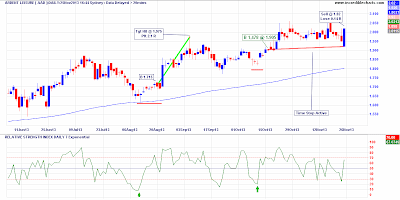So Far I have put up
charts for all the trades I have made for this system that had a July
start date. I like to look at my trades in blocks, almost as a
portfolio result, because I believe that trading isn't about any
individual trade, rather, it is a process of accumulating trades and their distribution of results. I will discuss this, and some of the following
maths, in another Method post in the near future but for now let's
look at this group of trades in a couple of useful ways.
The first way is to
calculate the expectancy in terms of risk. There were seven trades
in total in July. Each trade had a fixed amount of risk (referred to
as R) and the returns shown as multiples of R were (0.50), 2.78,
(0.21), 2.92, 0.09, 0.34 & 2.10
The simpler form of
calculating expectancy is (Win% x Avge Win) – (Lose% x Avge Loss)
so on the above numbers we had
5 winners
totaling 8.23R
2 losers totaling
0.71R
So the expectancy is
( (5/7) x (8.23/5) ) –
( (2/7) x (0.71/2) )
=> (0.714 x
1.646) – (0.286 x 0.355)
=> 1.175 – 0.102
So Expectancy for July
was = 1.07
The other useful way of
looking at returns is to round each return to the nearest R and chart
the distribution
What
I am looking for here is called Skewness - a
measure of symmetry, or more precisely, the lack of symmetry. A
distribution, or data set, is symmetric if it looks the same to the
left and right of the center point. It is skewed
if it bulges out to one side of center.
All
my efforts in trading are aimed at creating an uneven distribution of
returns with very few losses of more than 1R and many profits that
push as far to the right of the bell curve as possible.
By
either measure the July block of trades were stunningly good. I
generally expect to hit an expectancy of between 0.5 and 1.0 and a
win% of 42% - 52% over the long term but these trades were taken
during a sweet spot on the ASX. It's important not to get too
carried away by a small collection of trades as we will see in
forthcoming posts. This number of trades isn't even statistically
significant but one has to start somewhere.
























